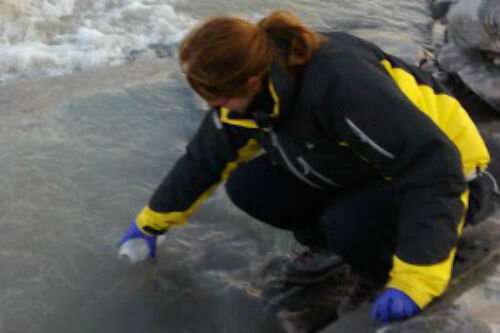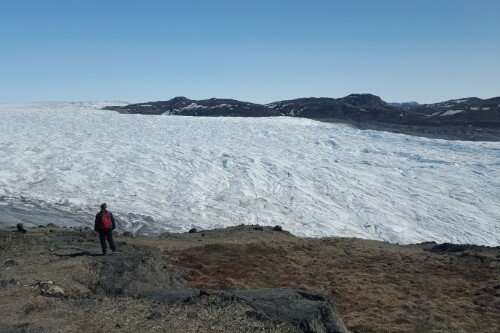Subglacial weathering alters nutrient cycles in Greenland

The nutrient cycles that underpin how carbon is stored and released from two of Greenland's glaciers is significantly affected by subglacial weathering, a new study has found, shedding further light on the geochemistry of meltwaters.
The study, led by a team of isotope geochemists and glaciologists from the University of Bristol, measured the geochemical signature of the silica released from the Leverett Glacier in Southwest Greenland and the Kiattuut Sermiat in South Greenland.
Silica is a key nutrient for some types of algae such as diatoms, which form the basis of many aquatic ecosystems and are responsible for carbon storage on a global scale.
At ~600 km2 Leverett Glacier is larger and so waters are likely to spend a longer time under the glacier, resulting in enhanced silicate mineral weathering. Whereas at 36 km2 Kiattuut Sermiat is much smaller and acts more like a small alpine glacier, dominated by carbonate weathering over the melt season. The difference in weathering regimes may impact the isotopic signature, as silicate weathering will lead to the formation of new, distinct solids, which will react and dissolve – given enough time.
"We wanted to determine if the distinct isotopic signature previously measured in Greenland was consistent in a different glacial catchment, and what processes might be causing this distinct isotopic signature," said Jade Hatton, University of Bristol Ph.D. student and lead author of the study, published in Geochimica et Cosmochimica Acta.

"We found that both Greenlandic catchments have an isotopic signature that is distinct from non-glacial rivers, despite their size differences. But there are differences between the catchments, which appear to correspond to differences in the weathering processes that are occurring under the glaciers themselves."
Co-author Dr. Kate Hendry added: "Our study gives us amazing new insights into how weathering processes underneath ice sheets and glaciers supply essential nutrients via meltwaters, which play a key role in driving regional ecosystems and could impact global biogeochemical cycles."
The study also considers the importance of the high rates of physical erosion in these systems, which results in finely crushed rocks, also influencing the geochemistry of meltwaters.
Researchers say there is still work to be done to continue improving our understanding of glacial weathering and how it impacts the nutrients exported in meltwaters. At present, this work builds on recent research by Dr. Jon Hawkings and team, which shows the impact of past ice sheets on the global silicon cycle.
The research team are continuing to work on other glacial systems to investigate whether the patterns seen in Greenland are consistent globally. By combining further field studies with laboratory experiments, they hope to provide the scientific community with a better constrained silicon isotopic composition of glacial rivers.
More information: J.E. Hatton et al. Investigation of subglacial weathering under the Greenland Ice Sheet using silicon isotopes, Geochimica et Cosmochimica Acta (2019). DOI: 10.1016/j.gca.2018.12.033
Journal information: Geochimica et Cosmochimica Acta
Provided by University of Bristol




















